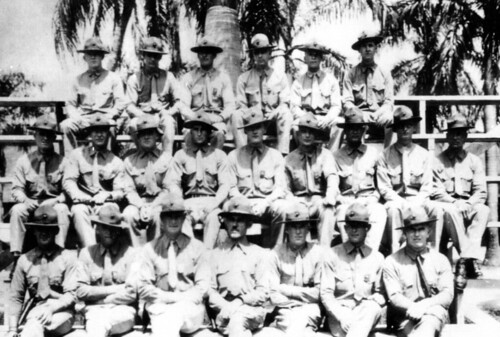Leprosy – Insular Patrol
Military mandated sanitation
From 1899 to 1941 US Marines given the title “Insular Patrolman” were selected to live in Guam’s villages and maintain order. Among their many duties was to enforce the island’s sanitary and public health regulations as dictated by the US Navy administration.
From the time the US gained control of Guam, the insular patrolmen became its eyes and ears – and enforcers – to ensure that its strict new rules were followed. The Naval administration exerted almost full control over Guam residents through its stringent regulations. The justification given for this was they were trying to improve the overall health of the island and for the protection of military personnel and the Chamorro people. Some of the sanitation and public health rules enforced included:
- weeds around homes could not reach beyond six-inches in height;
- laundered clothes must be dried at least eighteen inches from the ground; and,
- school girls were ordered to wear skirts which bottoms had to be at least four inches from the ground (effectively banning the use of the traditional mestisa).
Such regulations were put in place to promote hygiene and with respect to the rules on clothes, it was a measure to prevent dirt from getting on the clothing. The insular patrol had the power to ticket or issue fines to offenders. Repeat sanitation violators were arrested.
House-to-house inspections became an everyday reality in every village by the end of the first decade of Naval rule. The inspections were not limited to houses and grounds, but also for the identification of ailing Chamorros during epidemics.
Health regulations and leprosy
In 1902, Naval Governor Seaton Schroeder issued General Order No. 43 which mandated the segregation of people thought to have Hansen’s disease or leprosy. Not only did it establish a “leper colony” in Ypao on Tumon Bay, but it directed patrolmen to identify and apprehend suspect cases of Hansen’s disease. Those “diagnosed” with the disease were immediately confined at Tumon. Families were also fined or arrested for attempting to conceal or aid relatives in escaping confinement.
Chamorros were often misdiagnosed and treated as prisoners in the Tumon leprosarium. They were referred to as “inmates” instead of as patients suffering from a disease. In Colonial Dis-Ease, Guam historian Anne Perez Hattori writes of the misdiagnoses:
On Guam early in the 20th century, despite the certainty that the disease was a menace to the island, definition and treatment of it were still uncertain procedures. Ailments such as gangosa, yaws, and syphilis were frequently misdiagnosed as Hansen’s disease, and persons suspected of suffering from it were confined in a “leper colony” before undergoing a medical examination.
Dr. Anne Perez Hattori
Once at the colony, patients were guarded and not allowed to leave the premises, which were mostly surrounded by a high barbed wire fence. Visitors had to seek permission from the Naval governor to visit those confined at the colony. An article in the Guam Recorder, a newspaper at the time, stated that at night patients were placed in houses that had iron bars on the windows and padlocked doors.
This harsh treatment led many Chamorro families to flaunt the laws and attempt to conceal sick family members from the patrolmen. In addition to the already standing order to arrest family members caught hiding family members suspected of having the disease, Governor E.J. Dorn in 1910 began taking Chamorro parents who hid their sick children to court.
Schroeder and subsequent appointed governors considered their efforts to separate the “leper” from the community noble and in the best interests of the people on the island and the military’s mission. They defended the need for the establishment of the Tumon colony, the enforcement of confinement and the eventual exile of persons thought to have the disease. Governor George Dyer wrote in a 1905 letter to the assistant secretary of the Navy:
The necessity for the segregation of the lepers for the protection of the white population, and incidentally the existence and efficiency of the Naval Station, is unquestionable. This has been demonstrated in many places notably in Hawai’i.
In 1912, (this would be the first of several forced relocations until the practice ceased in 1924) close to 20 patients were involuntarily shipped to a larger colony on Culion Island in the Philippines. The prior year, Governor George R. Salisbury began the efforts to remove the patients to the Philippines. Navy administrators—and by extension the patrolmen—were unable to securely quarantine patients from the community.
Navy administrators believed that their inability to contain the patients could potentially cause the spread of the disease to military personnel and the community, and they also wanted to relieve the economic burden of detaining and feeding the patients. Most of the patients would never see their families again.
By Connor Murphy and Tanya M. Champaco Mendiola
For further reading
Angeny, G.L. “Leprosy in Guam.” The Military Surgeon: Journal of the Association of Military Surgeons of the United States 25, no. 1 (July 1909): 312-317.
Hattori, Anne Perez. Colonial Dis-ease: U.S. Navy Health Policies and the Chamorros of Guam, 1898-1941. Pacific Islands Monograph Series 19. Honolulu: University of Hawai’i Press, 2004.

